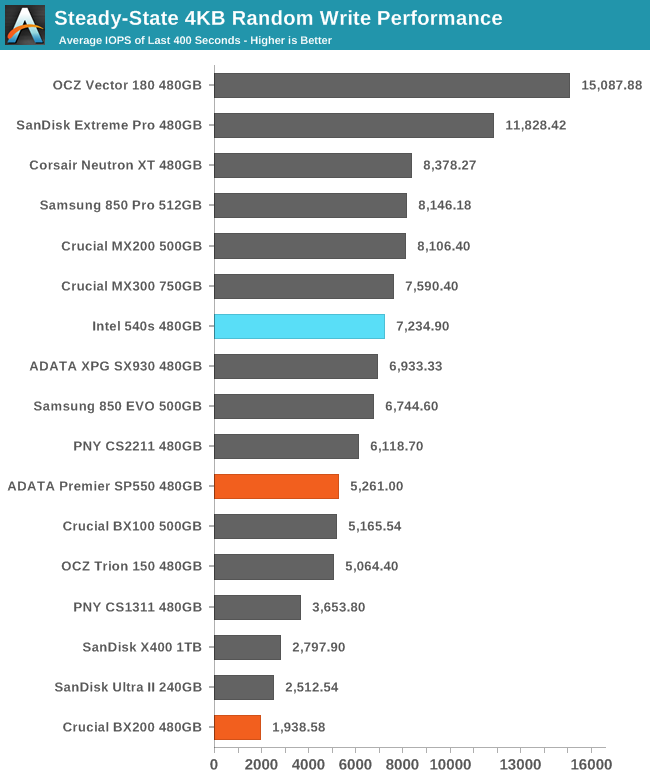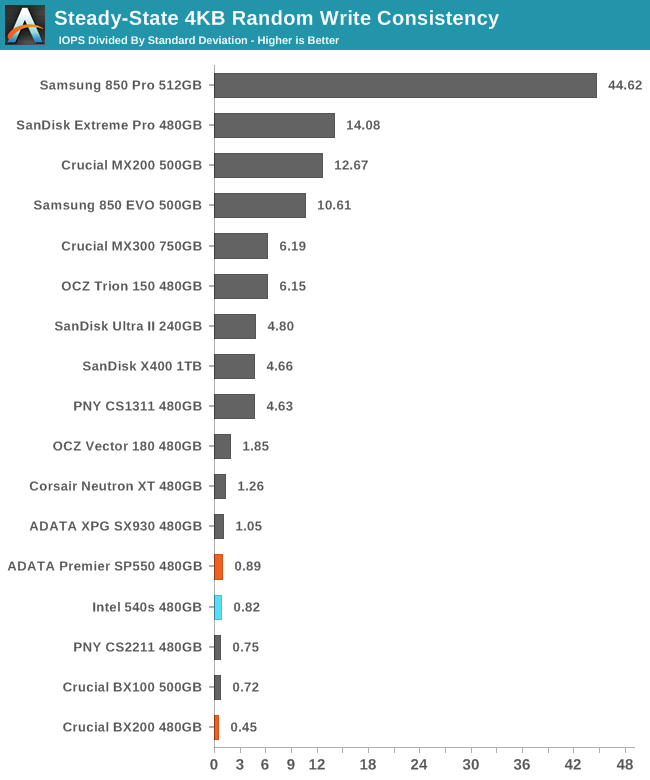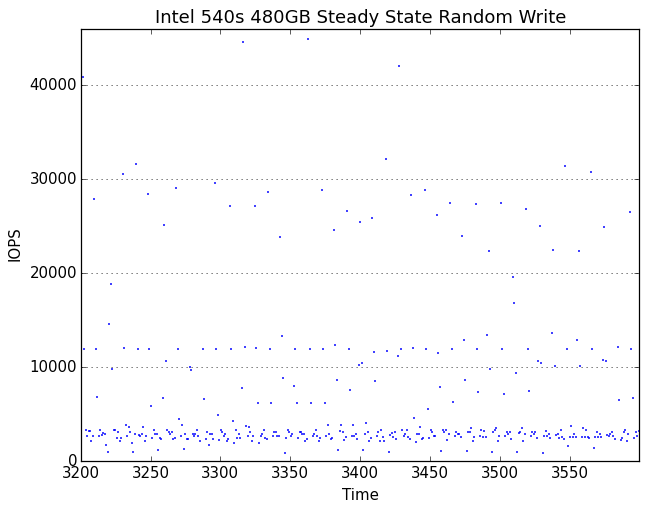The Intel SSD 540s (480GB) Review
by Billy Tallis on June 23, 2016 9:00 AM ESTPerformance Consistency
Our performance consistency test explores the extent to which a drive can reliably sustain performance during a long-duration random write test. Specifications for consumer drives typically list peak performance numbers only attainable in ideal conditions. The performance in a worst-case scenario can be drastically different as over the course of a long test drives can run out of spare area, have to start performing garbage collection, and sometimes even reach power or thermal limits.
In addition to an overall decline in performance, a long test can show patterns in how performance varies on shorter timescales. Some drives will exhibit very little variance in performance from second to second, while others will show massive drops in performance during each garbage collection cycle but otherwise maintain good performance, and others show constantly wide variance. If a drive periodically slows to hard drive levels of performance, it may feel slow to use even if its overall average performance is very high.
To maximally stress the drive's controller and force it to perform garbage collection and wear leveling, this test conducts 4kB random writes with a queue depth of 32. The drive is filled before the start of the test, and the test duration is one hour. Any spare area will be exhausted early in the test and by the end of the hour even the largest drives with the most overprovisioning will have reached a steady state. We use the last 400 seconds of the test to score the drive both on steady-state average writes per second and on its performance divided by the standard deviation.

Right from the start we see a substantial improvement of the SM2258 over SM2256, as steady-state random write speed has increased by 37%. This puts the Intel 540s well ahead of any other planar TLC drive and ahead of a few low-end MLC drives as well.

While the average random write speed has improved, the consistency is a bit worse and the Intel 540s scores in the bottom tier of drives. Phison's most recent generation of TLC drives managed to deliver very consistent steady state performance, but Silicon Motion still has a lot of room for improvement here.
 |
|||||||||
| Default | |||||||||
| 25% Over-Provisioning | |||||||||
The consistency of the 540s was clearly poor even before the transition to steady state, but during that early phase of the test it delivered twice the IOPS of the ADATA SP550.
 |
|||||||||
| Default | |||||||||
| 25% Over-Provisioning | |||||||||
Once in steady state, the 540s performance mostly stays slightly above the SP550. Both drives have frequent outliers beyond their band of usual performance, and the outliers are almost all in the direction of better performance. The Intel drive's outliers hit some much higher peaks than the ADATA SP550, suggesting that the new SM2258 controller may have significantly improved performance on bursty workloads.










77 Comments
View All Comments
Drasca - Tuesday, June 28, 2016 - link
There is a matter of scale. What is efficient for the small scale is not efficient for the large scale deployment.> even though it would probably save them a lot of dough
It wouldn't, it'd create the opposite effect costing them far more in the long run. You're thinking from the personal perspective where maintenence, reliability and security isn't an issue and non critical.
En mass, it costs them far more to have downtime, maintaining and replacing gear, than it does the initial purchase-- security notwithstanding either. They have to pay people time and money to keep the equipment up, whose price just snowballs as downtime accrues. The initial equipment cost is extremely fractional compared to the human resource cost of dealing with the equipment afterward, keeping track of it, security, physically replacing as it goes down, etc.
Buying from bulk also guarantees Hp/dell/lenovo has standardized problems and they replace the gear as it breaks wholesale. The equipment is closer to leased than purchased, with basically extended warranty guarantees. Consumer equipment does not have these protections and guarantees.
It costs far far far more in human resources spending time and money upkeeping a lot of gear that breaks, and all things will eventually break with this many pieces of equipment, taking up space that costs even more money, and causing a clusterfuck when you don't have government contracts.
The consumer level does not work at the government level and vice versa.
>entirely new workstation for that user.
They actually get entirely new workstations, for the most part. . . and old ones are worked to hell until budgets come in and approved for for upgrades across the board.
woggs - Thursday, June 23, 2016 - link
Intel doesn't ship unreliable drives (and will fix an issue if it slips out). That's the one thing you get from intel and is why they can get the big OEM orders. Other than that, I agree with "meh."trparky - Thursday, June 23, 2016 - link
For Christ's sake, why are we still using Planar NAND? Haven't we learned already that Flash memory at anything smaller than 19nm is just too unreliable? For God's sake! Everyone should be moving to 3D NAND already!trparky - Thursday, June 23, 2016 - link
Unless it's using 3D NAND, I won't buy it.ClockHound - Thursday, June 23, 2016 - link
3D? If it's not 4D, I'm not putting precious historically disposable data on it.chrcoluk - Sunday, July 17, 2016 - link
looks like its planar I am guessing by the small manufacturing size, one of the reasons ofr 3d nand is to use larger manufacturing process which has more reliable flash.16nm TLC is too scary for me.
euskalzabe - Friday, June 24, 2016 - link
Agreed. I was on the verge of buying a 512GB X400 but I think I'll wait until the fall, see what 3d NAND comes out...maxxbot - Thursday, June 23, 2016 - link
Who is this marketed for exactly? The X400 is faster AND cheaper, the 850 EVO is around the same price and much, much faster. It looks like you didn't even read the review.maxxbot - Thursday, June 23, 2016 - link
As for the reputable company comment, there's already a very reputable company out there that produces drives with much better price/performance: Samsung. Every corporate laptop I have had has had a Samsung SSD, why would they choose lower performance and higher price to go with this drive?alpha754293 - Monday, July 25, 2016 - link
Sadly though, my Intel 520 series SSDs performed better in random I/O (swapping) than this *NEW* Intel 540 series drive.The ONLY thing that has changed is cost. (I can buy a 1 TB 540 series drive at Microcenter for $250, and therefore; the $/GB has come down a LOT since the 520 series days), but for a 5-series drive, it certainly doesn't have the performance to match.
This was the same problem that I had with the 535 Series as well.
Whyyy would you release a NEW product that's actually inferior in measurable performance?
You would think that when you're buying a NEW drive, that you're getting the best that the company has to offer at this level. (Yes, I also have a 750 series PCIe x4 SSD as well, in case you were wondering (or not).)